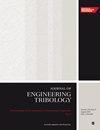混合润滑接触界面的改进声学模型
IF 1.8
3区 工程技术
Q3 ENGINEERING, MECHANICAL
Proceedings of the Institution of Mechanical Engineers, Part J: Journal of Engineering Tribology
Pub Date : 2023-12-03
DOI:10.1177/13506501231218315
引用次数: 0
摘要
混合润滑界面在工程中广泛应用。接触刚度的测量是设备性能评估的一个挑战。超声反射法是一种有效的测量方法,但声学模型的精确构建困难限制了测量精度。本文提出了一种改进的声学模型来分析混合润滑界面的接触刚度。该模型采用准静态弹簧模型、虚拟材料模型、统计微接触模型和多层声学模型构建。混合润滑界面相当于一个均匀的、各向同性的虚拟材料层。然后,通过引入厚度系数来确定虚拟层的力学、几何和声学参数。利用该模型计算了接触刚度,并与准静态弹簧模型和虚拟材料层模型进行了比较。利用基于计算参数的多层声学模型也可以计算出界面的反射系数。通过将预测的反射系数与已发表的实验结果进行比较,验证了该模型的正确性。本文章由计算机程序翻译,如有差异,请以英文原文为准。
An improved acoustic model for mixed lubrication contact interface
Mixed lubrication interfaces are widespread in engineering. The measurement of contact stiffness is a challenge for device performance evaluation. The ultrasonic reflection method is an effective method, but the difficulty of accurate construction of the acoustic model limits the measurement accuracy. In this study, an improved acoustic model is proposed to analyze the contact stiffness of the mixed lubrication interface. The model is constructed using a quasi-static spring model, virtual material model, statistical microcontact model, and multilayer acoustic model. The mixed lubrication interface is equivalent to a homogeneous and isotropic virtual material layer. Then, the mechanical, geometric, and acoustic parameters of the virtual layer are determined by introducing thickness coefficients. The contact stiffness is obtained with the proposed model and compared with the quasi-static spring model and the virtual material layer model. The reflection coefficient of the interface can also be calculated using a multilayer acoustic model based on the calculated parameters. The proposed model is verified by comparing the predicted reflection coefficients with the published experimental results.
求助全文
通过发布文献求助,成功后即可免费获取论文全文。
去求助
来源期刊

CiteScore
4.20
自引率
5.00%
发文量
110
审稿时长
6.1 months
期刊介绍:
The Journal of Engineering Tribology publishes high-quality, peer-reviewed papers from academia and industry worldwide on the engineering science associated with tribology and its applications.
"I am proud to say that I have been part of the tribology research community for almost 20 years. That community has always seemed to me to be highly active, progressive, and closely knit. The conferences are well attended and are characterised by a warmth and friendliness that transcends national boundaries. I see Part J as being an important part of that community, giving us an outlet to publish and promote our scholarly activities. I very much look forward to my term of office as editor of your Journal. I hope you will continue to submit papers, help out with reviewing, and most importantly to read and talk about the work you will find there." Professor Rob Dwyer-Joyce, Sheffield University, UK
This journal is a member of the Committee on Publication Ethics (COPE).
 求助内容:
求助内容: 应助结果提醒方式:
应助结果提醒方式:


